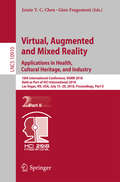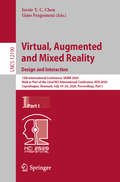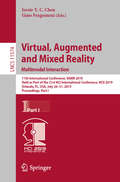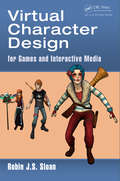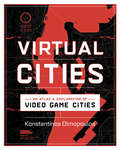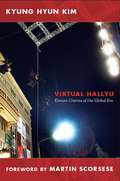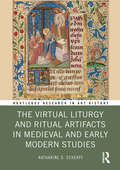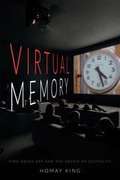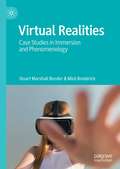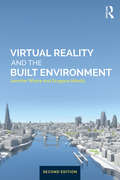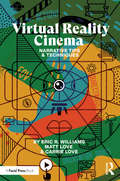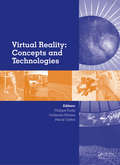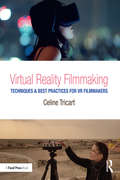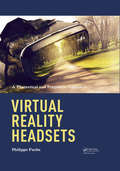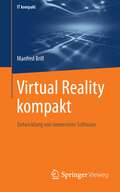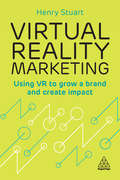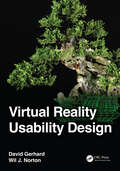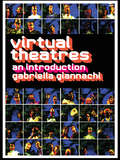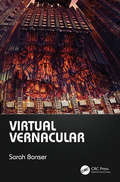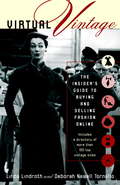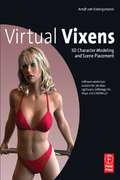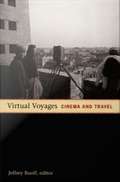- Table View
- List View
Virtual, Augmented and Mixed Reality: 10th International Conference, VAMR 2018, Held as Part of HCI International 2018, Las Vegas, NV, USA, July 15-20, 2018, Proceedings, Part II (Lecture Notes in Computer Science #10910)
by Jessie Y.C. Chen Gino FragomeniThis two-volume set LNCS 10909 and 10910 constitutes the refereed proceedings of the 10th International Conference on Virtual, Augmented and Mixed Reality, VAMR 2018, held as part of HCI International 2018 in Las Vegas, NV, USA. HCII 2018 received a total of 4346 submissions, of which 1171 papers and 160 posters were accepted for publication after a careful reviewing process. The 65 papers presented in this volume were organized in topical sections named: interaction, navigation, and visualization in VAMR; embodiment, communication, and collaboration in VAMR; education, training, and simulation; VAMR in psychotherapy, exercising, and health; virtual reality for cultural heritage, entertainment, and games; industrial and military applications.
Virtual, Augmented and Mixed Reality. Design and Interaction: 12th International Conference, VAMR 2020, Held as Part of the 22nd HCI International Conference, HCII 2020, Copenhagen, Denmark, July 19–24, 2020, Proceedings, Part I (Lecture Notes in Computer Science #12190)
by Gino Fragomeni Jessie Y. C. ChenThe 2 volume-set of LNCS 12190 and 12191 constitutes the refereed proceedings of the 12th International Conference on Virtual, Augmented and Mixed Reality, VAMR 2020, which was due to be held in July 2020 as part of HCI International 2020 in Copenhagen, Denmark. The conference was held virtually due to the COVID-19 pandemic.A total of 1439 papers and 238 posters have been accepted for publication in the HCII 2020 proceedings from a total of 6326 submissions.The 71 papers included in these HCI 2020 proceedings were organized in topical sections as follows:Part I: design and user experience in VAMR; gestures and haptic interaction in VAMR; cognitive, psychological and health aspects in VAMR; robots in VAMR.Part II: VAMR for training, guidance and assistance in industry and business; learning, narrative, storytelling and cultural applications of VAMR; VAMR for health, well-being and medicine.
Virtual, Augmented and Mixed Reality. Multimodal Interaction: 11th International Conference, VAMR 2019, Held as Part of the 21st HCI International Conference, HCII 2019, Orlando, FL, USA, July 26–31, 2019, Proceedings, Part I (Lecture Notes in Computer Science #11574)
by Jessie Y. C. Chen Gino FragomeniThis two-volume set LNCS 11574 and 11575 constitutes the refereed proceedings of the 11th International Conference on Virtual, Augmented and Mixed Reality, VAMR 2019, held in July 2019 as part of HCI International 2019 in Orlando, FL, USA. HCII 2019 received a total of 5029 submissions, of which 1275 papers and 209 posters were accepted for publication after a careful reviewing process. The 80 papers presented in this volume were organized in topical sections named: multimodal interaction in VR, rendering, layout, visualization and navigation, avatars, embodiment and empathy in VAMR, cognitive and health issues in VAMR, VAMR and robots, VAMR in learning, training and entertainment, VAMR in aviation, industry and the military.
Virtual Character Design for Games and Interactive Media
by Robin James SloanWhile the earliest character representations in video games were rudimentary in terms of their presentation and performance, the virtual characters that appear in games today can be extremely complex and lifelike. These are characters that have the potential to make a powerful and emotional connection with gamers. As virtual characters become more
Virtual Cities: An Atlas And Exploration Of Video Game Cities
by Konstantinos DimopoulosImmerse yourself in 45 spectacularly imagined virtual cities, from Arkham City to Whiterun, in this beautifully illustrated unofficial guide. Spanning decades of digital history, this is the ultimate travel guide and atlas of the gamer imagination. Dimopoulos invites readers to share his vision of dozens of different gaming franchises like never before: discover Dimopoulos’s Half-Life 2’s City 17, Yakuza 0’s Kamurocho, Fallout’s New Vegas, Super Mario Odyssey’s New Donk City, and many more. Each chapter of this virtual travel guide consists of deep dives into the history and lore of these cities from an in-universe perspective. Illustrated with original color ink drawings and—of course—gorgeous and detailed maps, readers can explore the nostalgic games of their youth as well as modern hits. Sidebars based on the author’s research tell behind-the-scenes anecdotes and reveal the real-world stories that inspired these iconic virtual settings. With a combination of stylish original maps, illustrations, and insightful commentary and analysis, this is a must-have for video game devotees, world-building fans, and game design experts.
Virtual Hallyu: Korean Cinema of the Global Era
by Kyung Hyun Kim"[T]his fine book . . . . enlarges our vision of one of the great national cinematic flowerings of the last decade."--Martin Scorsese, from the forewordIn the late 1990s, South Korean film and other cultural products, broadly known as hallyu (Korean wave), gained unprecedented international popularity. Korean films earned an all-time high of $60.3 million in Japan in 2005, and they outperformed their Hollywood competitors at Korean box offices. In Virtual Hallyu, Kyung Hyun Kim reflects on the precariousness of Korean cinema's success over the past decade. Arguing that state film policies and socioeconomic factors cannot fully explain cinema's true potentiality, Kim draws on Deleuze's concept of the virtual--according to which past and present and truth and falsehood coexist--to analyze the temporal anxieties and cinematic ironies embedded in screen figures such as a made-in-the-USA aquatic monster (The Host), a postmodern Chosun-era wizard (Jeon Woo-chi), a schizo man-child (Oasis), a weepy North Korean terrorist (Typhoon), a salary man turned vengeful fighting machine (Oldboy), and a sick nationalist (the repatriated colonial-era film Spring of Korean Peninsula). Kim maintains that the full significance of hallyu can only be understood by exposing the implicit and explicit ideologies of protonationalism and capitalism that, along with Korea's ambiguous post-democratization and neoliberalism, are etched against the celluloid surfaces.
The Virtual Life of Film
by D. N. RodowickAs almost (or, truly, virtually) every aspect of making and viewing movies is replaced by digital technologies, even the notion of "watching a film" is fast becoming an anachronism. With the likely disappearance of celluloid film stock as a medium, and the emergence of new media competing for an audience, what will happen to cinema--and to cinema studies? In the first of two books exploring this question, D. N. Rodowick considers the fate of film and its role in the aesthetics and culture of moviemaking and viewing in the twenty-first century. Here Rodowick proposes and examines three different critical responses to the disappearance of film in relation to other time-based media, and to the study of contemporary visual culture. Film, he suggests, occupies a special place in the genealogy of the arts of the virtual: while film disappears, cinema persists--at least in the narrative forms imagined by Hollywood since 1915. Rodowick also observes that most so-called "new media" are fashioned upon a cinematic metaphor. His book helps us see how digital technologies are serving, like television and video before them, to perpetuate the cinematic as the mature audiovisual culture of the twentieth century--and, at the same time, how they are preparing the emergence of a new audiovisual culture whose broad outlines we are only just beginning to distinguish.
The Virtual Liturgy and Ritual Artifacts in Medieval and Early Modern Studies (Routledge Research in Art History)
by Katharine D. ScherffExamining the history of altar decorations, this study of the visual liturgy grapples with many of the previous theoretical frameworks to reveal the evolution and function of these ritual objects. Using an interdisciplinary approach, this book uses traditional ar- historical methodologies and media technology theory to reexamine ritual objects. Previous analysis has not considered the in-between nature of these objects as deliberate and virtual conduits to the divine. The liturgy, the altarpiece, the altar environment, relics, and their reliquaries are media. In a series of case studies, several objects tell a different story about culture and society in medieval Europe. In essence, they reveal that media and media technologies generate and modulate the individual and collective structure of feelings of sacredness among assemblages of humans and nonhumans. The book will be of interest to scholars working in art history, medieval studies, early modern studies, and architectural history.
Virtual Memory: Time-Based Art and the Dream of Digitality
by Homay KingIn Virtual Memory, Homay King traces the concept of the virtual through the philosophical works of Henri Bergson, Gilles Deleuze, and Giorgio Agamben to offer a new framework for thinking about film, video, and time-based contemporary art. Detaching the virtual from its contemporary associations with digitality, technology, simulation, and speed, King shows that using its original meaning--which denotes a potential on the cusp of becoming--provides the means to reveal the "analog" elements in contemporary digital art. Through a queer reading of the life and work of mathematician Alan Turing, and analyses of artists who use digital technologies such as Christian Marclay, Agnès Varda, and Victor Burgin, King destabilizes the analog/digital binary. By treating the virtual as the expression of powers of potential and change and of historical contingency, King explains how these artists transcend distinctions between disembodiment and materiality, abstraction and tangibility, and the unworldly and the earth-bound. In so doing, she shows how their art speaks to durational and limit-bound experience more than contemporary understandings of the virtual and digital would suggest.
Virtual Realities: Case Studies in Immersion and Phenomenology
by Stuart Marshall Bender Mick BroderickVirtual Realities presents a ground-breaking application of phenomenology as a critical method to explore the impact of immersive media. Specific case studies examine 360-degree documentary productions about trauma, virtual military simulations, VR exposure therapy for anxiety and posttraumatic stress disorder, and the emerging debate about regulating violent content in immersive media gaming. By addressing these texts primarily as experiences, Virtual Realities deploys an analytic and critical methodology that is sensitive to the bodily and cognitive impact of immersive media, especially via the body of an appropriately attentive researcher-critic. Virtual Realities provokes a rethinking of many of the taken-for-granted ideas and assumptions circulating in the field of immersive media. These include concepts of empathy, embodiment, the affective impact of textual and immersive properties on the users’ experience, as well as the “gee-whizz” mentality often associated with approaches to the medium. The case studies provide fresh engagement with immersive media such as cinematic VR at a time when dominant attitudes about the technology display an evangelical fascination with VR and other mixed realities as inexorably beneficial. Virtual Realities makes a compelling case for VR-phenomenology to be employed as a methodology by humanities scholars and also in cross-disciplinary applications of immersive media in fields such as psychology, human-computer interaction studies and the health sciences.
Virtual Reality and the Built Environment
by Jennifer Whyte Dragana NikolićLike the first edition, the central question this book addresses is how virtual reality can be used in the design, production and management of the built environment. The book aims to consider three key questions. What are the business drivers for the use of virtual reality? What are its limitations? How can virtual reality be implemented within organizations? Using international case studies it answers these questions whilst addressing the growth in the recent use of building information modelling (BIM) and the renewed interest in virtual reality to visualize and understand data to make decisions. With the aim of inspiring and informing future use, the authors take a fresh look at current applications in the construction sector, situating them within a broader trajectory of innovation. The new edition expands the scope to consider both immersive virtual reality as a way of bringing professionals inside a building information model, and augmented reality as a way of taking this model and related asset information out to the job-site. The updated edition also considers these technologies in the context of other developments that were in their infancy when the first edition was written – such as laser scanning, mobile technologies and big data. Virtual Reality in the Built Environment is essential reading for professionals in architecture, construction, design, surveying and engineering and students on related courses who need an understanding of BIM, CAD and virtual reality in the sector. Please follow the book's Twitter account: @vrandbe http://buildingvr.blogspot.co.uk/
Virtual Reality Cinema: Narrative Tips and Techniques
by Eric R. Williams Carrie Love Matt LoveAward-winning cine-maVRicks Eric R. Williams, Carrie Love and Matt Love introduce virtual reality cinema (also known as 360° video or cine-VR) in this comprehensive guide filled with insider tips and tested techniques for writing, directing and producing effectively in the new medium. Join these veteran cine-VR storytellers as they break down fundamental concepts from traditional media to demonstrate how cine-VR can connect with audiences in new ways. Examples from their professional work are provided to illustrate basic, intermediate and advanced approaches to crafting modern story in this unique narrative space where there’s no screen to contain an image and no specific stage upon which to perform. Virtual Reality Cinema will prepare you to approach your own cine-VR projects via: Tips and techniques for writing, directing and producing bleeding-edge narrative cine-VR projects; More than a hundred photos and illustrations to explain complex concepts; Access to more than two hours of on-line cine-VR examples that you can download to watch on your own HMD; New techniques developed at Ohio University’s Game Research and Immersive Design (GRID) Lab, including how to work with actors to embrace Gravity and avoid the Persona Gap, how to develop stories with the Story Engagement Matrix and how to balance directorial control and audience agency in this new medium. This book is an absolute must read for any student of filmmaking, media production, transmedia storytelling and game design, as well as anyone already working in these industries that wants to understand the new challenges and opportunities of virtual reality cinema.
Virtual Reality: Concepts and Technologies
by Philippe Fuchs Guillaume Moreau Pascal GuittonA manual for both designers and users, comprehensively presenting the current state of experts' knowledge on virtual reality (VR) in computer science, mechanics, optics, acoustics, physiology, psychology, ergonomics, ethics, and related area. Designed as a reference book and design guide to help the reader develop a VR project, it presents the read
Virtual Reality Designs
by Adriana Peña Pérez Negrón Graciela Lara López Héctor Rafael Orozco AguirreVirtual Reality is not real life. Instead it is life-like creations using computer-generated scenarios. Human behavior is replicated in virtual scenarios, where every detail is controlled by computers, and in situations that can be repeated under the same conditions. Based on technology and design, the user can experience presence. In the virtual world, users are embodied in avatars that represent them and are the means to interact with the virtual environment. Avatars are graphical models that behave on behalf of the human behind them. The user avatar is a proxy that also backs interaction with others, allowing computer-mediated interactions. Analyses directed to understand people’s perceptions, personal and social behavior in computer mediated interactions, comprise a multidisciplinary area of study that involves, among others, computer science, psychology and sociology. In the last two decades a number of studies supported by Virtual Reality have been conducted to understand human behavior, in some cases the implications of the technology, or to reproduce artificial human behavior. This book presents a collection of studies from recognized researchers in the area.
Virtual Reality Filmmaking: Techniques & Best Practices for VR Filmmakers
by Celine TricartVirtual Reality Filmmaking presents a comprehensive guide to the use of virtual reality in filmmaking, including narrative, documentary, live event production, and more. Written by Celine Tricart, a filmmaker and an expert in new technologies, the book provides a hands-on guide to creative filmmaking in this exciting new medium, and includes coverage on how to make a film in VR from start to finish. Topics covered include: The history of VR; VR cameras; Game engines and interactive VR; The foundations of VR storytelling; Techniques for shooting in live action VR; VR postproduction and visual effects; VR distribution; Interviews with experts in the field including the Emmy-winning studios Felix & Paul and Oculus Story Studio, Wevr, Viacom, Fox Sports, Sundance’s New Frontier, and more.
Virtual Reality Headsets - A Theoretical and Pragmatic Approach
by Philippe FuchsThe purpose of virtual reality is to make possible a sensorimotor and cognitive activity for a user in a digitally created artificial world. Recent advances in computer technology have led to a new generation of VR devices such as VR headsets. Accordingly, virtual reality poses many new scientific challenges for researchers and professionals. The aim of this book, a manual meant for both designers and users of virtual reality, is to present the current state of knowledge on the use of VR headsets in the most complete way possible. The book is divided into 13 chapters. The objective of the first chapter is to give an introduction to VR and clarify its scope. The next chapter presents a theoretical approach to virtual reality through our Immersion and Interaction methodology also known as "3I² model’’. Then, a chapter about human senses is necessary to understand the sensorimotor immersion, especially vision. These chapters are followed by several chapters which present the different visual interfaces and the VR headsets currently available on the market. These devices can impart comfort and health problems due to sensorimotor discrepancies. A chapter is devoted to these problems, followed by a chapter that gives a detailed discussion of methods and 32 solutions to dispel, or at least to decrease, VR sickness. The following three chapters present different VR applications that use VR headsets (behavioural sciences, industrial uses and Digital Art) and the final chapter provides conclusions and discusses future VR challenges.
Virtual Reality kompakt: Entwicklung von immersiver Software (IT kompakt)
by Manfred BrillVirtual Reality ist immer noch eine Technologie, die sich extrem schnell verändert. Ständig wird neue Hardware entwickelt, die neue Anwendungen hervorbringt und die Weiterentwicklung der dafür nötigen Softwaren erzwingt. Die Themen Immersion, Interaktivität und die Gestaltung des User Interfaces in einer immersiven Anwendung haben au den Konferenzen wie der IEEE VR oder der ISMAR immer noch einen großen Stellenwert.Dieses Buch konzentriert sich auf die Software-Entwicklung von VR-Anwendungen. Dabei werden Werkzeuge aus der Praxis wie Unity, Unreal und andere frei verfügbare SDKs vorgestellt und in Fallstudien eingesetzt. Nach einer Einführung in die Grundlagen der virtuellen Realität konzentrieren wir uns auf allgemeine Aspekte der Software-Entwicklung. Hauptthema sind Portabilität am Beispiel von OpenXR und generische und wiederverwendbare Bausteine für die Implementierung von Benutzungsoberflächen. Wie wir diese Bausteine in den Werkzeugen vorfinden oder selbst implementieren ist anschließend das Thema. Letztendlich werden die Leser ein eigenes Framework für diese Techniken entwickeln, die anschließend in den eigenen Anwendungen verwendet werden können. Die Lösungen der Aufgaben, insbesondere die Quelltexte der vorgestellten Software sind in einem öffentlichen GitHub-Repository verfügbar. Im letzten Abschnitt des Buchs werden immersive Anwendungen im Bereich der Strömungsdynamik, der Volumengrafik und des Immersive Learnings vorgestellt, realisiert und weiter entwickelt.
Virtual Reality Marketing: Using VR to Grow a Brand and Create Impact
by Henry StuartIf a picture is worth a thousand words, then virtual reality (VR) is priceless. This new medium is booming - by 2025, the industry is expected to become bigger than TV. Virtual Reality Marketing is a comprehensive exploration of all things VR, providing readers with everything they need to know about the current VR landscape, and the unprecedented opportunity it offers brands to create unique emotional connections with consumers. A truly comprehensive guide, Virtual Reality Marketing covers all aspects of the industry, including interactive and passive VR, 360 video, social VR marketing, and the role that influencers and bloggers are set to play in its development. It also looks to the future - exploring how VR is evolving and the changes it will undergo in the future. Virtual Reality Marketing is the only complete guide to VR marketing available, written by a recognized industry expert who has facilitated VR coverage for major international brands including Facebook, Audi, Google and Mercedes F1. Packed with fascinating case studies, tips and strategies, this text is the leading resource for any reader looking to incorporate VR in their own marketing campaigns.
Virtual Reality Usability Design
by David Gerhard Wil J. NortonThe development of effective and usable software for spatial computing platforms like virtual reality (VR) requires an understanding of how these devices create new possibilities (and new perils) when it comes to interactions between humans and computers. Virtual Reality Usability Design provides readers with an understanding of the techniques and technologies required to design engaging and effective VR applications. The book covers both the mechanics of how human senses and the mind experience immersive virtual environments, as well as how to leverage these mechanics to create human-focused virtual experiences. Deeply rooted in principles of human perception and computational interaction, the current and future limitations of these replacements are also considered. Full of real-world examples, this book is an indispensable guide for any practising VR developer interested in making efficient and effective interfaces. Meanwhile, explorations of concrete theory in their practical application will be useful for VR students and researchers alike.
Virtual Theatres: An Introduction
by Gabriella GiannachiThe first full-length book of its kind to offer an investigation of the interface between theatre, performance and digital arts, Virtual Theatres presents the theatre of the twenty-first century in which everything - even the viewer - can be simulated. In this fascinating volume, Gabriella Giannachi analyzes the aesthetic concerns of current computer-arts practices through discussion of a variety of artists and performers including: * blast Theory* Merce Cunningham* Eduardo Kac* forced entertainment* Lynn Hershman* Jodi Orlan* Guillermo Gómez-Peña* Marcel-lí Antúnez Roca* Jeffrey Shaw* Stelarc. Virtual Theatres not only allows for a reinterpretation of what is possible in the world of performance practice, but also demonstrates how 'virtuality' has come to represent a major parameter for our understanding and experience of contemporary art and life.
Virtual und Augmented Reality: Grundlagen und Methoden der Virtuellen und Augmentierten Realität (eXamen.press)
by Ralf Dörner, Wolfgang Broll, Paul Grimm and Bernhard JungDas Lehrbuch vermittelt die theoretischen und praktischen Grundlagen, die benötigt werden, um Virtual- und Augmented-Reality-Systeme (VR/AR) eigenständig zu realisieren oder zu erweitern. Es dient Studierenden als anschauliche Begleitlektüre zu Lehrveranstaltungen, die VR/AR thematisieren, u. a. in den Fächern Informatik, Medien oder Natur- und Ingenieurwissenschaften. Durch seinen modularen Aufbau eignet sich der Band auch für das Selbststudium und kann darüber hinaus als Nachschlagewerk verwendet werden.
Virtual Vernacular
by Sarah BonserLearn to see the patterns and relationships in visual mediums and buildings as you push the boundaries of design. Sarah Bonser’s Virtual Vernacular breaks the barriers between architectural theory and game design. The text explores the way in which architecture can convey history, culture, and emotion to occupants, audience members, and players. Divided into three sections, the text guides the reader on how to tackle creative problem solving and development strategy. Key Features: Architectural theory is hard to navigate, and this approach is an accessible way to start learning it. Learn more specifically how pop culture parodies these design theories. Find ways to solve abstract design problems by using the built environment as a case study. Learn about technical limitations on the built environment that visually impact the look and feel of spaces. Each piece of architectural theory comes with abstracts and applications, which is a more organized and network-style way to teach an otherwise long-winded subject.
Virtual Vintage: The Insider's Guide to Buying and Selling Fashion Online
by Linda Lindroth Deborah Newell TornelloVintage clothing has never been more chic, with everyone from celebrity trendsetters to style-conscious professionals searching for wearable treasures from the past. Virtual Vintage is the first and only guide that helps both the novice and the fashion connoisseur evaluate and confidently participate in the thriving vintage marketplace that exists online. No other book explains how to get it, sell it, fix it, or wear it with flair. Authors Linda Lindroth and Deborah Newell Tornello equip readers from head to toe with * more than 100 chic sites--rated and evaluated * instructions on contacting sellers * smart strategies for bidding in online auctions * advice about evaluating the size, quality, and colors of a garment * tips for cleaning and repairing vintage items Whether you're looking for a 1960s Rudi Gernreich knit, Gucci hipster trousers, a Claire McCardell for Townley shirtwaist, or a Chanel suit in pink wool with black patent-leather trim, Virtual Vintage will help you build a unique and sensational wardrobe.
Virtual Vixens: 3D Character Modeling and Scene Placement
by Arndt Von KoenigsmarckFeatures software workshops for 3ds Max, Maya, CINEMA 4D, Lightwave, and Softimage XSI.Hot, hotter, hottest. See how today's leading modeling artists create 3D characters that sizzle and get the techniques you'll need to create your own virtual vixens.Steven Stahlberg, Liam Kemp, Marco Patrito, and Sze Jones from Blur Studio are just a few of the 3D artists who share their secrets for making the fantasy females you wish were real. You'll get their personal stories, insights into the profession, and new ways to conceive and construct your own 3D characters.Then, seven hands-on workshops demonstrate the complete work cycle of modeling 3D characters to bring your own fantasies to life-from making the first sketch and preparing the template to modeling and texturing characters and lighting and rendering. You can use the techniques with any of the major software tools including 3ds Max, Lightwave, Softimage XSI, Maya, or Cinema 4D. Since the workshops don't use any previously made objects, you'll get to start from scratch with your imagination as the only limit.Participants:Andrea BertacciniMax Edwin WahyudiSze JonesLiam KempArndt von KoenigsmarckK. C. LeeDaniel Moreno DiazMarco PatritoSteven StahlbergFrancois de Swardt
Virtual Voyages: Cinema and Travel
by Jeffrey RuoffVirtual Voyages illuminates the pivotal role of travelogues within the history of cinema. The travelogue dominated the early cinema period from 1895 to 1905, was central to the consolidation of documentary in the 1910s and 1920s, proliferated in the postwar era of 16mm distribution, and today continues to flourish in IMAX theaters and a host of non-theatrical venues. It is not only the first chapter in the history of documentary but also a key element of ethnographic film, home movies, and fiction films. In this collection, leading film scholars trace the intersection of technology and ideology in representations of travel across a wide variety of cinematic forms. In so doing, they demonstrate how attention to the role of travel imagery in film blurs distinctions between genres and heightens awareness of cinema as a technology for moving through space and time, of cinema itself as a mode of travel. Some contributors take a broad view of travelogues by examining the colonial and imperial perspectives embodied in early travel films, the sensation of movement that those films evoked, and the role of live presentations such as lectures in our understanding of travelogues. Other essays are focused on specific films, figures, and technologies, including early travelogues encouraging Americans to move to the West; the making and reception of the documentary Grass (1925), shot on location in Turkey, Syria, Iraq, and Iran; the role of travel imagery in 1930s Hollywood cinema; the late-twentieth-century 16mm illustrated-lecture industry; and the panoramic possibilities presented by IMAX technologies. Together the essays provide a nuanced appreciation of how, through their representations of travel, filmmakers actively produce the worlds they depict. Contributors. Rick Altman, Paula Amad, Dana Benelli, Peter J. Bloom, Alison Griffiths, Tom Gunning, Hamid Naficy, Jennifer Lynn Peterson, Lauren Rabinovitz, Jeffrey Ruoff, Alexandra Schneider, Amy J. Staples
